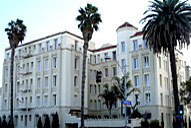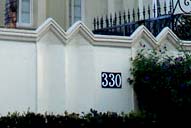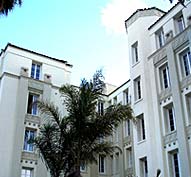




330 California Ave.
National Register of Historic Places
Architect: Max Maltzman


Charmont Apartments
photo by Michael Grandcolas

detail

Another view
photo by Michael Grandcolas
This stucco over brick structure with raised or incised details combines Mediterranean Revival and Art Deco Styles. Enjoy how the main doors are located across a walled courtyard featuring a two-tiered fountain with an intricate Moorish-patterned backsplash. Consistent with Med-Deco style, featured stucco areas are patterned or scored. The Charmont Apartments use of chevron points as a design theme can be seen on pair piers through the courtyard wall and on the windows, adding to the aesthetic appeal.
The Charmont Apartments are a quintessential example of Mediterranean Revival architecture combining expressions of Italian, Moorish, North African and Southern Spanish themes.
During the mid 1910s through the early 1930s Mediterranean Revival style was applied to hotels, apartment buildings, commercial structures, and even modest residences. Its architectural vocabulary was characterized by stucco walls, low pitched terra cotta tile roofs, arches, scrolled or tile capped parapet walls and articulated door surrounds, sometimes utilizing Spanish Baroque decorative motifs and Classical elements. Feature detailing was occasionally executed in keystone.
In the 1920s, Mediterranean Revival blended with Art Deco. Named "Med-Deco"
in areas where the style proliferated, like the Ocean Beach section of
Miami, the look was a synthesis of Mediterranean Revival form and Art
Deco decorative detail. This unique hybrid style became a fascinating
bridge between the "familiar" and the "new" as the
allure of Art Deco found its way into Santa Monica’s architectural
vocabulary.